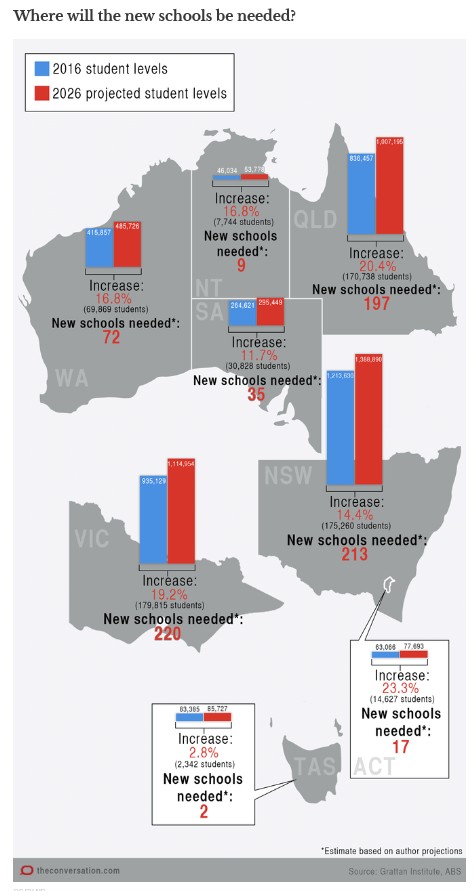The immigration-driven population boom in Sydney – which has added 830,000 people (20%) to Sydney’s population over the past 12 years and is projected to increase Sydney’s population by 87,000 people a year (1.74 million in total) over the next 20 years – is the gift that keeps on giving.
Back in December and January (here and here), The ABC reported that Sydney’s public schools are suffering from chronic over-crowding as they struggle to keep pace with rampant population growth.
Today, The SMH reports that the NSW Government (read taxpayers) must embark on a $5 billion in additional spending to meet “an unprecedented explosion in student numbers in the next 15 years and relieve chronic overcrowding”:
As figures show state school enrolments are set to surge by 21 per cent, or 164,000, by 2031 the NSW government has produced the School Assets Strategic Plan as its blueprint for how to respond…
It comes as Fairfax Media can also reveal a $50 million cost blowout at the flagship, high-rise Arthur Phillip high school at Parramatta, from $175 million to $225 million…
Options in the plan include partnerships with developers and councils to provide funding for school infrastructure that can be shared with local communities; “modular classroom blocks” in place of demountable classrooms; and building larger schools on smaller sites…
In planning new and redeveloped schools there will be standard enrolment capacities of 1000 students for primary schools and 2000 for secondary schools, significantly up from the present maximums of 640 and 1190…
The blueprint says by 2031 the number of students in NSW government schools will jump from 780,000 in 2016 to 944,500, of which 80 per cent will occur in Sydney.
This represents 96,500 extra primary students and 67,500 extra secondary students.
The overcrowding of Sydney’s schools is just one area of collateral damage from Australia’s mass immigration program. To this you can add worsening traffic congestion, deteriorating housing affordability, and an overall erosion of public services and livability.
Back in February 2016, Peter Goss, School Education Program Director at the Grattan Institute, penned an excellent article in The Conversation assessing the upcoming shortage of schools across Australia’s capital cities as the nation’s population balloons. This article estimated that the number of school students would balloon by 650,000 (17%) by 2026, which would require the building of an additional 400 to 750 new schools (up from 9,400 currently). NSW (mostly Sydney) would need an additional 213 schools to cope with an additional 14% of students over the next decade, whereas Victoria (mostly Melbourne) would require an additional 220 schools to cope with an additional 19% of students (see below graphic).

Inner city areas would be worst affected by the schools shortage, according to Grattan:
In the inner city, the big issue is the cost and scarcity of land… Governments have been much worse at planning for the booming number of inner-city children…
All of this, yet again, highlights Australia’s dysfunctional population ponzi in action. And to make matters even worse, the Turnbull Government recently relaxed visa rules to allow 6 year-old foreign students and their guardians visa entry into Australia’s primary schools, thus adding to the demand pressures.
To the NSW Government’s credit, they have at least acknowledged the problem and are searching for a solution. But surely part of this solution should be to tap the federal government on the shoulder and ask it to lower the immigration intake, in turn relieving pressure on public services, infrastructure and housing?
Indeed, former NSW Treasury boss, Percy Allen, has the right idea:
The Australian government is fiscally broke. It’s running a huge budget deficit that is adding to its interest bill…
To alleviate demand pressure on social services, education and health the government should halve the permanent immigration intake.
To avoid any racist overtones the humanitarian component should be expanded. Significantly slowing Australia’s population growth would also reduce pressure on house prices, city congestion and stagnant wages.
Exactly. Instead of spending billions of taxpayer dollars, why not remove the demand pressures causing the overcrowding in the first place?

